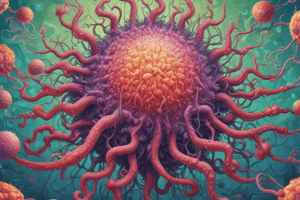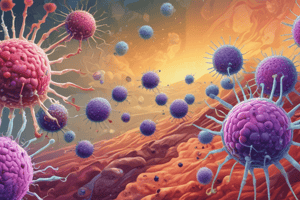Podcast
Questions and Answers
The ______ tract is the most common portal of entry for viruses.
The ______ tract is the most common portal of entry for viruses.
Respiratory
Viruses contained in larger droplets are deposited in the ______ respiratory tract.
Viruses contained in larger droplets are deposited in the ______ respiratory tract.
upper
Antibodies of the ______ isotype bind to virus particles in the respiratory tract.
Antibodies of the ______ isotype bind to virus particles in the respiratory tract.
IgA
The ciliated epithelial cells of the respiratory tract display receptors for ______ viruses, such as influenza or rhinovirus.
The ciliated epithelial cells of the respiratory tract display receptors for ______ viruses, such as influenza or rhinovirus.
The small intestine contains ______ cells, goblet cells and glands that secrete mucus.
The small intestine contains ______ cells, goblet cells and glands that secrete mucus.
Under the epithelium of the small intestine, lymph node–like masses called ______ patches contain millions of antibody-secreting lymphocytes.
Under the epithelium of the small intestine, lymph node–like masses called ______ patches contain millions of antibody-secreting lymphocytes.
Successful viruses must also be resistant to the ______ pH of stomach acid.
Successful viruses must also be resistant to the ______ pH of stomach acid.
Viruses are able to gain entry into the body through a variety of different portals, including the ______ tract.
Viruses are able to gain entry into the body through a variety of different portals, including the ______ tract.
The membrane envelopes of most enveloped viruses are disintegrated by ______ acid.
The membrane envelopes of most enveloped viruses are disintegrated by ______ acid.
Acid-labile viruses are unable to withstand the low pH of the ______.
Acid-labile viruses are unable to withstand the low pH of the ______.
Viruses can be transmitted from mother to child in ______ milk.
Viruses can be transmitted from mother to child in ______ milk.
[Blank] virus is an example of a virus that can be transmitted via the fecal-oral route.
[Blank] virus is an example of a virus that can be transmitted via the fecal-oral route.
Human ______ virus (HPV) has a tropism for the epithelium of the cervix or penis.
Human ______ virus (HPV) has a tropism for the epithelium of the cervix or penis.
[Blank] glands produce oil that creates an acidic environment, making viral attachment difficult.
[Blank] glands produce oil that creates an acidic environment, making viral attachment difficult.
Tears function to wash away any potential ______.
Tears function to wash away any potential ______.
Viral conjunctivitis, also known as “______ eye,” is usually caused by adenoviruses.
Viral conjunctivitis, also known as “______ eye,” is usually caused by adenoviruses.
A host typically goes through four stages of disease development when it is infected with a ______.
A host typically goes through four stages of disease development when it is infected with a ______.
The ______ period is the time between when the virus initially infects the host and when symptoms appear.
The ______ period is the time between when the virus initially infects the host and when symptoms appear.
During the prodromal period, nonspecific, mild symptoms, such as ______, muscle aches, or a low-grade fever occur.
During the prodromal period, nonspecific, mild symptoms, such as ______, muscle aches, or a low-grade fever occur.
The illness period occurs when specific symptoms of the disease occur, and the virus is multiplying to high levels and the ______ system has been activated.
The illness period occurs when specific symptoms of the disease occur, and the virus is multiplying to high levels and the ______ system has been activated.
The ______ period is when the symptoms of the disease subside as the host begins feeling better.
The ______ period is when the symptoms of the disease subside as the host begins feeling better.
The convalescent period may last for days or months, depending upon the ______ of the infection.
The convalescent period may last for days or months, depending upon the ______ of the infection.
Papillomavirus strains that infect the skin replicate locally in the ______.
Papillomavirus strains that infect the skin replicate locally in the ______.
Viruses initiate infection through one organ but then spread to other sites within the body, causing ______ infections.
Viruses initiate infection through one organ but then spread to other sites within the body, causing ______ infections.
In ______ spread, viruses spread to target organs using the bloodstream.
In ______ spread, viruses spread to target organs using the bloodstream.
The term used to describe the presence of virus within the bloodstream is ______.
The term used to describe the presence of virus within the bloodstream is ______.
Viruses that infect the skin are spread through ______-to-skin contact.
Viruses that infect the skin are spread through ______-to-skin contact.
The shedding of virus refers to the release of infectious ______ from the host.
The shedding of virus refers to the release of infectious ______ from the host.
Viruses that replicate in the lungs, nasal cavity, or salivary glands can be shed in ______.
Viruses that replicate in the lungs, nasal cavity, or salivary glands can be shed in ______.
The presence of virus within the urine is known as ______.
The presence of virus within the urine is known as ______.
Some acute infections are inapparent or ______, meaning that they produce no symptoms of disease.
Some acute infections are inapparent or ______, meaning that they produce no symptoms of disease.
Still replicates, activates the immune system and spread to other hosts, these are known as ______ infections.
Still replicates, activates the immune system and spread to other hosts, these are known as ______ infections.
[Blank] infections can also result from viral latency or slow infections.
[Blank] infections can also result from viral latency or slow infections.
A state in which the virus becomes dormant within host cells is called ______ latency.
A state in which the virus becomes dormant within host cells is called ______ latency.
An example of a virus that establishes ______ latency is the varicella zoster virus that causes chickenpox.
An example of a virus that establishes ______ latency is the varicella zoster virus that causes chickenpox.
HIV establishes a ______ infection, it takes around 8–10 years for an individual to progress to a stage of disease where symptoms are apparent.
HIV establishes a ______ infection, it takes around 8–10 years for an individual to progress to a stage of disease where symptoms are apparent.
Flashcards are hidden until you start studying
Study Notes
Virus Transmission and Pathogenesis
- Viral pathogenesis: the process by which viruses cause disease within a host
- Two conditions for a successful infection:
- Sufficient numbers of virions must enter the host
- Host cells must be accessible to the virus and susceptible to infection
- Affinity for susceptible tissues is known as tropism
Portals of Virus Entry
- Respiratory Tract:
- Most common portal of entry
- Viruses contained in larger droplets are deposited in the upper respiratory tract, while smaller aerosolized particles or liquids travel into the lower respiratory tract
- Flow of mucus and cilia trap many viral particles
- Gastrointestinal Tract:
- Small intestine contains M cells, goblet cells, and glands that secrete mucus
- Peyer’s patches contain antibody-secreting lymphocytes, macrophages, and other immune system cells
- Successful viruses must be resistant to low pH of stomach acid and detergent qualities of bile
- Genital Tract:
- Viruses can be transmitted via sexual activity or mother-to-child through breast milk
- Tropism of human papillomavirus (HPV) for the epithelium of the cervix or penis
- Viruses must overcome local barriers to infection, such as mucus and low pH of the vagina
- Skin:
- Two layers of tissue: epidermis and dermis
- Viruses can enter through small cuts or abrasions, insect vectors, or improperly sterilized equipment
- Eyes:
- External layer composed of sclera and cornea
- Tears wash away potential pathogens, and traumatic events can provide entry points for viruses
Systemic Infections
- Viruses can initiate infection through one organ and spread to other sites within the body
- Two ways of spreading:
- Hematogenous spread: using the bloodstream (e.g., through animal or insect bites)
- Neurotropic spread: using neurons (e.g., herpesviruses)
Portals of Virus Exit
- Shedding of virus: release of infectious virions from the host
- Methods of shedding:
- Respiratory viruses: respiratory secretions, coughing, or sneezing
- Gastrointestinal viruses: aerosolized vomit or diarrhea, contaminating food or water
- Skin viruses: skin-to-skin contact
- Genital viruses: semen or vaginal secretions
- Viremia: presence of virus within the bloodstream
- Viruria: presence of virus within the urine
Patterns of Infection
- Four stages of disease development:
- Incubation period: time between initial infection and symptom appearance
- Prodromal period: symptoms first appear, with nonspecific, mild symptoms
- Illness period: symptoms of the disease occur, with the immune system activated
- Convalescent period: symptoms subside as the host begins feeling better
- Persistent infections: when the host immune system is unable to clear the virus, but the virus does not replicate to lethal levels
- Viral latency: state in which the virus becomes dormant within host cells
- Slow infections: viruses that take years to reach a symptomatic phase (e.g., HIV)
Studying That Suits You
Use AI to generate personalized quizzes and flashcards to suit your learning preferences.




